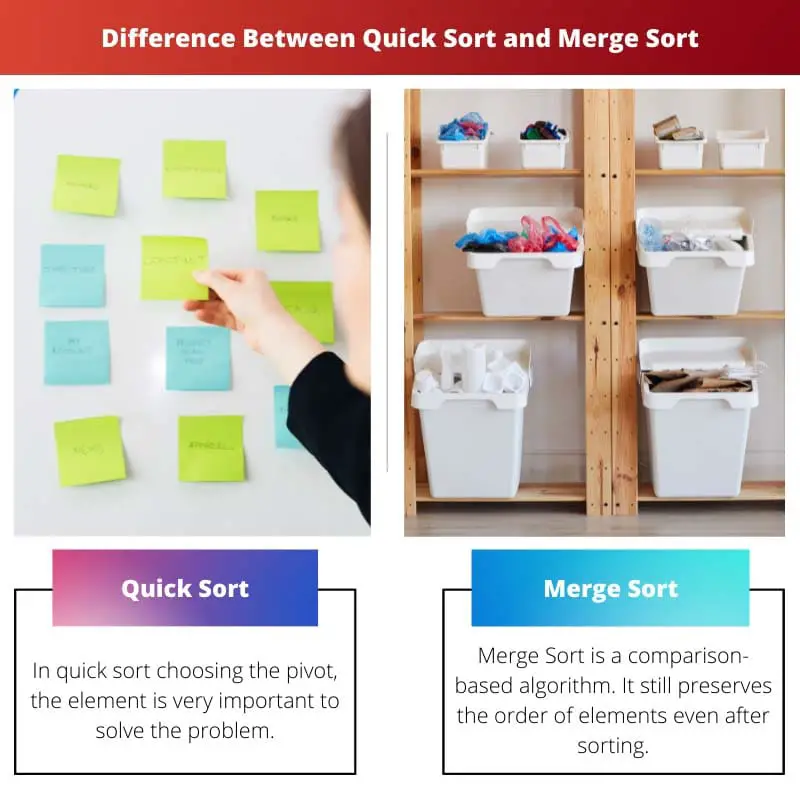Sorting is the method used to arrange the elements in proper order. It is a technique used in Data Structures and Algorithms. Sorting can be done using many methods.
Both Quicksort and Merge Sort use the divide and conquer method to sort the elements. It is a method where we will partition the elements into two and will combine them after rearranging the elements.
Key Takeaways
- Quick Sort is a sorting algorithm that uses a pivot element to divide the array into two partitions and recursively sort them. In contrast, Merge Sort divides the array into two halves, sorts them separately, and merges them.
- Quick Sort has a worst-case time complexity of O(n^2), but on average, it has a time complexity of O(n log n), whereas Merge Sort has a guaranteed time complexity of O(n log n).
- Quick Sort is an in-place sorting algorithm, meaning it doesn’t require additional memory, while Merge Sort requires additional memory to store the temporary arrays during the merge step.
Quick Sort vs Merge Sort
Quick sort is a sorting algorithm that uses a divide-and-conquer approach to sort an array or list of elements. Quick sort is efficient and is used in practice. Merge sort is a divide-and-conquer algorithm that divides an array into two halves. It is useful for large data sets.

In quick sort, you choose any random element and name it a pivot. This is the element that will divide or partition the array if you are confused about which element should be taken as a pivot.
Then you can go for the first element as the pivot element. The worst-case is o (n^2). The average case is o (n log n). The best case is o (n).
Merge sort is one of the most frequently used and respected algorithms in data structures. It has many advantages when compared with quicksort because of its time complexity. The worst-case is o (n log n). The average case is o (n log n). The best case is o (n log n).
Comparison Table
| Parameters of Comparison | Quick Sort | Merge Sort |
|---|---|---|
| Definition | It is one of the sorting algorithms to place the elements in order. | It is an algorithm used to sort the elements by comparing them. |
| Space | It uses minimum space. | It uses more space. |
| Array Efficiency | It is good to work with smaller arrays. | It can work with all types of arrays. |
| Working Speed | It will work faster for smaller data sets. | It maintains the same speed for all data sets. |
| Method of Sorting | It uses Internal Sorting. | It uses External Sorting. |
What is Quick Sort?
In quick sort choosing the pivot, the element is very important to solve the problem. One simple mistake will take more time. Once you finish the partition process, make the elements divided into two.
Such as, one row should contain elements that are less than the pivot, and the other row should contain elements greater than the pivot.
Then the next step is to sort the elements recursively. The leftmost section is called the left partition. The rightmost section is called the right partition. Dividing the problem into two means you are reducing it into a linear time-bound. This is the reason for its average time complexity.
Quick Sort is to be used when you think you have very few elements. Because when you try to sort it with a large number of elements, you might make a mistake if you try to do it for the first time. Also, it takes more time to solve the problem for bigger elements.
It is an easier method as it requires a limited amount of space and some good knowledge. The pivot element compares the element to its left and right sides as well. It used to do this till all the elements were arranged in proper order.

What is Merge Sort?
Merge Sort is a comparison-based algorithm. It still preserves the order of elements even after sorting. It is used to split the array into two sections. It will sort each array and then combine them together. This sorting technique requires additional memory space to sort the auxiliary array.
Since this divides the element again and again till it becomes one, this technique reduces the sorting time. This method uses three arrays. The first two arrays are used for storing half of the elements. Then the next one is used to store the final sorted list of arrays.
After this process, each array will be sorted recursively. One of the key steps in merge sort is you have to identify the breakpoints. It is basically identifying the ascending or descending number in the set of elements. Then store them in the array and finally merge them using the techniques.
Merge sort is a great place to start with the divide and conquer process. The disadvantage is that it has to make all the elements of the subarray in a separate recursive cell, but the answer will be precise. One of the important concepts related to the merge sort algorithm is the inversion method.

Main Differences Between Quick Sort and Merge Sort
- Merge Sort gives you a precise value irrespective of a large number of elements but takes more space to calculate than quicksort.
- Merge sort is somewhat faster when compared with quicksort.
- Quicksort is mostly based on swapping the elements. On the other hand, merge sort is based on merging the sorted arrays.
- Quicksort requires some additional memory for recursion. But Merge sort requires additional memory for both recursions as well as for merging.
- Quicksort is faster when compared with merge sort in solving the problem because of its space requirement.






